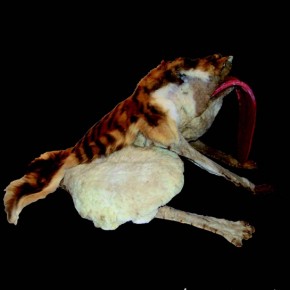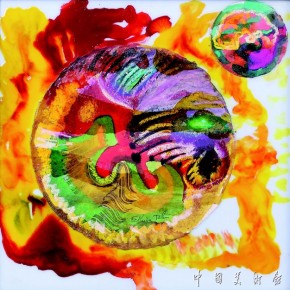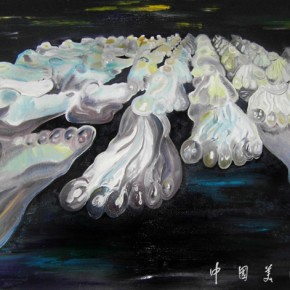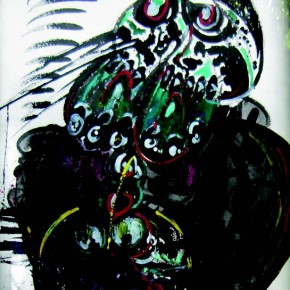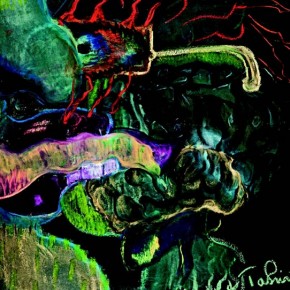
Her brush strokes are more nervous, the colours light up with new vibrations: the bright reds, the glowing white and the yellows take on the colour of scorched earth to transform not only the canvas but everything around it into theatre. A theatre animated with strange, sometimes disturbing figures, starving, whose teeth emerge from the background. Such research is nourished by the inexhaustible strength of the problems that plague the artist: violence, selfishness, injustice, the mysterious roots that become a gam of metamorphosis. Fathia Tahiri thus provokes an aesthetic revolution, swinging between an idea of beauty seen as loyalty to an unaltered model and the study of new forms, seeking to quench the endless need for a poetic renewal, the intimate essence of art.
----Paolo De Grandis
Fathiya Tahiri's latest solo exhibition is going to be held at the National Art Museum of China from March 1 through to March 14, 2013. Entitled "Introspection", the exhibition reflects the individuality of the artist who is always pondering over the? self consciousness, subconsciousness as well as her surroundings. She is always ready to find and create paintings which can fully reflect her feelings and her perception of the outside world.
Fathiya Tahiri was born in 1959 in Rabat, the capital of the Kingdom of Morocco. Coming from an old family of Fes, she spends her childhood between Rabat and Casablanca. Her first artistic works date back to her early childhood; she sculpts shapes out of everything she finds, candles, clay, soil, fabrics… Her first drawing works date back to when she was 15 years old, which is when her architect vocation takes shape. At the age of 18, she leaves for France where she pursues her studies at the Paris School of Architecture (Ecole Spéciale d’Architecture). These few years spent in the city of light, allow her artwork to gain maturity. “My history with the materials dates back to the age of innocence I am told, where as a child, I felt the silk hypnotized by the softness of its texture and the shimmering of its colors. Then came drawing, sculpture and woodwork that I practiced as hobbies. My architect vocation was the culmination of this leaning nature.”
In 1986, she opens her architectural firm in Rabat and carries out a number of grand projects in several Moroccan cities, and simultaneously creates furniture art pieces which she exhibits at the Mohamed V theater in Rabat and Casablanca. She then, expresses her art in the details of her architecture. “In the practice of my profession, I explored my country and I have had the revelation of its colored souks.” In Ouarzazate, I discovered incredible varieties of precious or semi-precious stones which seemed to be born from the burning sun of this city nested at the gate of the desert. Just as its red walls and its men with their profiles carved in the rocks; I took the gems in my hand, and tossed and turned them around over and again. They burned the palm of my hand, dazzled my eyes, and fascinated me by their glare. These thousands of facets which tell the story of generations of nomads buying or selling ores, thus leaving their know-how as a seed which was to later hatch into a multitude of rustic jewels, ranging from the anklet, heavy as a chain of love, to the engraved fibule, from a necklace which decorate a set of circles and rhombuses enameled to the multiform rings where at times one may find encrusted a luminous stone”
Expression by way of sculpture becomes vital for her; she presents several of her works in private exhibitions. Then the subject becomes more demanding, she delves into sculptures for the body, jewelry. “I connected this rich initiation of the tangle of the centuries, the races and the ethnic groups to my memory imbued by the smoothness of the ornaments of the women of my cradle city, where the fine gold set with emeralds, garnished with pearls, engraved by expert hands. I started by assembling the stones and their lights forming cascades running on throats or dancing around necks. So in the same fashion that I carved the stone into a flower or a bird perched on its branch, and that I decorated my architect walls; I started to work as an autodidact with gold and silver, which yielded to the shapes coming from my sole imagination. The woman thus became for me, the privileged space on which I put lay down my jewelry such as the extension of her own beauty. And just like any artist on the move, never stops in her tracks nor looks back, I converted myself into a sculptor, once again inspired by my Architect trade. In 2002, Fathiya Tahiri is invited to exhibit her SCULPTURES PER IL CORPO at the Correr Museum - of Venice in the “Napoleonean Wing”. The exhibition of a very great wealth is placed under the high patronage of His Majesty King Mohammed VI. It is the ultimate recognition. She then cumulates several sculpture exhibitions. She then exhibits her silver sculptures at the Open Arte & Cinema “Film Festival” of Venice in 2003 and in 2004 her first painting works at the Parisian gallery Artcurial and a monumental sculpture at Mostra of Venice. “Painting came to me in a very abrupt and violent way. The pain of its arrival is always present, in each painting. It erodes me and calls me again unceasingly.”
In 2005, Fathiya Tahiri represents Morocco with two other artists at the Biennale of Venice. She chooses as exhibition place the Church Chiesa S.Maria della Pieta. “My painting is an act of faith, it is my expression, and even the exhibition spaces must express themselves along with it. The choice of the Church Chiesa S.Maria della Pieta for the Moroccan pavilion was very important to me. This tolerance and this spirituality in which bathed my youth; I wanted it to be expressed to the World.”
About the exhibition
Duration: March 1-14, 2013
Venue: Gallery 6, the National Art Museum of China
Organizer: Embassy of the Kingdom of Morocco in China


